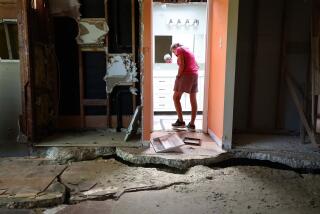$11 Million Later, Break in Pt. Loma Sewage Pipe Fixed
- Share via
After discharging up to 180 million gallons of partially treated waste each day for more than two months, the rupture in the city’s sewage outfall pipeline was repaired early Saturday.
City workers and contractors met yesterday’s completion target date, despite vexing weather conditions and a second minor leak. The city set the deadline shortly after the Coast Guard discovered on Feb. 2 that several segments of the massive pipe had come apart.
The cost of 63 days of repairs was an estimated $11 million. Another $4.5 is expected to be spent on covering the pipe with “armor rock” for stability and protection, City Manager Jack McGory said.
The cause of the break is still under investigation.
For the past seven weeks, teams of workers traded 12-hour shifts, 7 days a week, with breaks only for inclement weather. The 70 divers, pipe layers, tugboat skippers, helicopter pilots, engineers, technicians and tradesmen were weary Saturday, but cheered by the completion.
“Yeah, when they put the pipe together, there were a few high-fives,” said Marc Stearns, repair project manager.
Mayor Maureen O’Connor gave pipeline supervisors three bottles of champagne for a celebration following the 5 a.m. reopening of the sewage line. Earlier, O’Connor and McGory were taken by helicopter to inspect operations on the repair barge above the damaged section of pipe, situated about 3/4 of a mile from shore. From there, they observed the coupling of the final segment.
The next step, O’Connor said, is to reopen beaches that have been quarantined because of the spill.
“We’ll do our best to . . . make sure all the quarantine signs are down for spring break,” O’Connor said, referring to this Friday when local schools go on vacation. O’Connor spoke to reporters at the Point Loma sewage treatment plant from which the pipe extends.
Quarantines were lifted from some parts of Mission Bay Friday and from parts of Ocean Beach Saturday. Beaches on Coronado were also opened to the public.
Coliform bacteria counts at stretches of beach near the Point Loma outfall and other outlets for urban runoff still tested more than 1,000 bacteria per 100 milliliters of water--the safe standard used by the county. During the worst periods, county health authorities quarantined 19 1/2 miles of San Diego coast, with readings reaching as high as 60,000 near the treatment center. Cumulatively, about 11-billion gallons of partially treated sewage spewed from the break.
Imperial Beach, Dog Beach, Narragansett Street, and parts of Mission Bay near Tecolote and Rose creeks will remain closed until counts diminish. The count at Narragansett Street on Saturday exceeded 16,000, Stephany said.
Lingering high counts in some areas are the result of street runoff from recent storms, and another sewage spill from a sewage pumping station in Tijuana, Stephany said.
Weather conditions will continue to affect water quality, Stephany said.
Sunlight helps kill the coliform, he said, and the afternoon clearing predicted this week may help to lower bacteria levels in the water.
The National Weather Service forecast for this week calls for morning fog and low clouds, giving way to sunshine and temperatures on the coast in the low 70s.
Even if the weather does clear, Stephany said, the mayor’s prediction for lifting the quarantines may be premature.
“Friday might be a little bit optimistic,” Stephany said. “It would be foolish to rush it.”
The Regional Water Quality Control Board earlier asked the city to hire an independent investigator to determine the cause of the break. Failure Analysis Associates, the firm that investigated the space shuttle Challenger explosion and the Exxon Valdez wreck, was chosen.
A preliminary report on the investigation is expected by the first week of May, McGory said.
Theories on the cause of the outfall rupture vary widely. They include the settling of the ocean floor combined with heavy wave action. City officials cite this theory most often.
Another theory is based on human error. Five workers at the Point Loma treatment plant told The Times last month that a mistake in handling trapped air inadvertently in the outfall pipe created what is known as a “water hammer,” according to terminology used by workers. The five workers said the force of a huge air bubble rushing through the pipe may have shaken several segments from their foundation. The workers said a disruption involving an air bubble occurred on Jan. 31.
The city has been named in several claims connected to the sewage spill, including one by 38 fishermen who say the rupture has damaged the ecosystem in the waters off Point Loma.
The city has yet to respond to the claim, McGory said. If the investigation by Failure Analysis Associates concurs with the city’s “external force” explanation for the break, the city assumes no liability, McGory said. If liability is determined, the outfall is covered by insurance, McGory said.
A third causal theory is based on deep gouges found on more than 200 feet of pipe, city officials said. The scrapings, some as far as a mile offshore, have fed speculation that an anchor, or a heavy object being towed by a ship, may have bumped the pipe and triggered the spill.
As the repair project wound down Saturday, and workers were given their first day off in as long as 7 weeks, McGory was asked to comment on the possibility of another break.
He replied that technology has advanced since the pipe was constructed. The repaired section is stronger, lighter and better secured, McGory said.
Can it happen again?
“I can’t guarantee this won’t happen again,” McGory said. “I can say this pipe is in a heck of a lot better shape than before it broke.”
More to Read
Sign up for Essential California
The most important California stories and recommendations in your inbox every morning.
You may occasionally receive promotional content from the Los Angeles Times.










